Rover Company
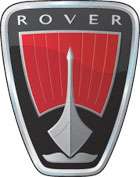 | |
| Industry |
Automotive industry Motorcycle industry (until 1925) Bicycle industry (until 1925) |
|---|---|
| Fate |
Merged into Leyland Motors (1967) Assets separated as Land Rover (1978) Rover brand defunct (2005) |
| Successor | British Leyland Motor Corporation |
| Founded | 1878 |
| Founder |
John Kemp Starley & William Sutton |
| Defunct | 2005 |
| Headquarters |
England: Coventry, West Midlands (1904–47) Solihull, West Midlands (1947–1981) Gaydon, West Midlands (1981–2000) Longbridge, West Midlands (2000–2005) |
Key people |
Spencer & Maurice Wilks (Management & Engineering, 1929–63) John Towers |
| Products |
Rover Automobiles Motorcycles (until 1925) Bicycles (until 1925) Land Rover All terrain vehicles |
| Subsidiaries | Alvis Cars (1965–67) |
Rover is a former British car manufacturing company founded as Starley & Sutton Co. of Coventry in 1878. It is the direct ancestor of the present day Land Rover marque, which is now a brand of Jaguar Land Rover, in turn owned by the Tata Group.
The company traded as Rover, manufacturing cars between 1904 and 1967, when it was sold to Leyland Motor Corporation, becoming the Rover marque. The Rover marque was used on cars produced by British Leyland (BL), who separated the assets of the original Rover Company as Land Rover in 1978 whilst the Rover trademark continued to be used on vehicles produced by its successor companies – the Austin Rover Group (1982–1986), the Rover Group (1986–2000), and then finally MG Rover (2000–2005). Following MG Rover's collapse in 2005, the Rover marque became dormant, and was subsequently sold by BMW to Ford, who had bought Land Rover from BMW in 2000. The rights to the Rover brand were transferred along with the Jaguar Cars and Land Rover businesses, to Tata Motors in 2008.
After developing the template for the modern bicycle with its Rover Safety Bicycle of 1885, the company moved into the automotive industry. It started building motorcycles and Rover cars, using their established marque with the iconic Viking Longship, from 1904 onwards. Land Rover vehicles were added from 1948 onwards, with all production moving to the Solihull plant after World War II.
The Polish word now most commonly used for bicycle – rower originates from Rover bicycles which had both wheels of the same size (previous models usually had one bigger, one smaller – see Penny-farthing, and were called in Polish bicykl, from English bicycle).
History
Before cars
.jpg)
.jpg)
The first Rover was a tricycle manufactured by Starley & Sutton Co. of Coventry, England, in 1883. The company was founded by John Kemp Starley and William Sutton in 1878. Starley had previously worked with his uncle, James Starley (father of the cycle trade), who began by manufacturing sewing machines and switched to bicycles in 1869.
In the early 1880s, the cycles available were the relatively dangerous penny-farthings and high-wheel tricycles. J.K. Starley made history in 1885 by producing the Rover Safety Bicycle—a rear-wheel-drive, chain-driven cycle with two similar-sized wheels, making it more stable than the previous high-wheel designs. Cycling Magazine said the Rover had "set the pattern to the world"; the phrase was used in their advertising for many years. Starley's Rover is usually described by historians as the first recognisably modern bicycle.
The words for "bicycle" in Polish (Rower) and Belarusian (Rovar, Ро́вар) are derived from the name of the company. The word ровер is also used in many parts of Western Ukraine.
In 1889, the company became J.K. Starley & Co. Ltd., and in the late 1890s, the Rover Cycle Company Ltd.
Rover motorcycles
In 1899 John Starley imported some of the early Peugeot motorcycles from France in for experimental development. His first project was to fit an engine to one of his Rover bicycles. Starley died early in October 1901 aged 46 and the business was taken over by entrepreneur H. J. Lawson.[1]

The company developed and produced the Rover Imperial motorcycle in November 1902. This was a 3.5 hp diamond-framed motorcycle with the engine in the centre and 'springer' front forks which was ahead of its time.[2] This first Rover motorcycle had innovative features such as a spray carburettor, bottom-bracket engine and mechanically operated valves. With a strong frame with double front down tubes and a good quality finish, over a thousand Rover motorcycles were sold in 1904. The following year, however, Rover stopped motorcycle production to concentrate on their 'safety bicycle' but in 1910 designer John Greenwood was commissioned to develop a new 3.5 hp 500 cc engine with spring-loaded tappets, a Bosch magneto and an innovative inverted tooth drive chain. It had a Brown and Barlow carburettor and Druid spring forks. This new model was launched at the 1910 Olympia show and over 500 were sold.
In 1913 a 'TT' model was launched with a shorter wheelbase and sports handlebars. The 'works team' of Dudley Noble and Chris Newsome had some success and won the works team award.[2]

Rover supplied 499 cc single cylinder motorcycles to the Russian Army during the First World War.[2] The company began to focus on car production at the end of the war, but Rover still produced motorcycles with 248 cc and 348 cc Rover overhead valve engines and with J.A.P. engines, including a 676 cc V-twin.[3] In 1924 Rover introduced a new lightweight 250cc motorcycle with unit construction of engine and gearbox. This had lights front and rear as well as a new design of internal expanding brakes.[2]
Poor sales of their motorcycles caused Rover to end motorcycle production and concentrate solely on the production of motor cars. Between 1903 and 1924 Rover had produced more than 10,000 motorcycles.[3]
Early Rover cars
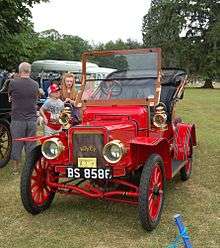
_(cropped).jpg)
_(cropped).jpg)

In 1888, Starley made an electric car, but it never was put into production.
Three years after Starley's death in 1901, and H. J. Lawson's subsequent takeover, the Rover company began producing automobiles with the two-seater Rover Eight to the designs of Edmund Lewis, who came from Lawson's Daimler. Lewis left the company to join Deasy in late 1905. He was eventually replaced by Owen Clegg, who joined from Wolseley in 1910 and set about reforming the product range. Short-lived experiments with sleeve valve engines were abandoned, and the 12hp model was introduced in 1912. This car was so successful that all other cars were dropped, and for a while, Rover pursued a "one model" policy. Clegg left in 1912 to join the French subsidiary of Darracq and Company London.
During the First World War, they made motorcycles, lorries to Maudslay designs, and, not having a suitable one of their own, cars to a Sunbeam design.
Restructure and re-organization
The business was not very successful during the 1920s and did not pay a dividend from 1923 until the mid-1930s. In December 1928 the chairman of Rover advised shareholders that the accumulation of the substantial losses of the 1923–1928 years together with the costs of that year's reorganisation must be recognised by a reduction of 60 per cent in the value of capital of the company.[4][5]
During 1928 Frank Searle was appointed managing director to supervise recovery. Searle was by training a locomotive engineer with motor industry experience at Daimler and, most recently, had been managing director of Imperial Airways. On his recommendation Spencer Wilks was brought in from Hillman as general manager and appointed to the board in 1929. That year, Searle split Midland Light Car Bodies from Rover in an effort to save money[6] and instructed Robert Boyle and Maurice Wilks to design a new small car.
This was the Rover Scarab with a rear-mounted V-twin-cylinder air-cooled engine announced in 1931, a van version was shown at Olympia, but it did not go into production.[7] During this time the Rover 10/25 was introduced, with bodies made by the Pressed Steel Company. This was the same body as used on the Hillman Minx. Prior to this time Rover had been a great supporter of the very light Weymann bodies that went suddenly out of fashion with the demand for shiny coachwork and more curved body shapes. Weymann bodies remained in the factory catalogue until 1933.
Frank Searle and Spencer Wilks set about reorganising the company and moving it upmarket to cater for people who wanted something "superior" to Fords and Austins. In 1930 Spencer Wilks was joined by his brother, Maurice, who had also been at Hillman as chief engineer. Spencer Wilks was to stay with the company until 1962, and his brother until 1963.
The company showed profits in the 1929 and 1930 years but with the economic downturn in 1931 Rover reported a loss of £77,529. 1932 produced a loss of £103,000 but a turn around following yet more reorganization resulted in a profit of £46,000 in 1933.[8] The new assembly operations in Australia and New Zealand were closed.
Frank Searle left the board near the end of the calendar year 1931, his work done.[6]
Building on successes such as beating the Blue Train for the first time in 1930 in the Blue Train Races, the Wilks Brothers established Rover as a company with several European royal, aristocratic, and governmental warrants, and upper-middle-class and star clients.[9]
Second World War and gas turbines
In the late 1930s, in anticipation of the potential hostilities that would become the Second World War, the British government started a rearmament programme, and as part of this, "shadow factories" were built. These were paid for by the government but staffed and run by private companies. Two were run by Rover: one, at Acocks Green, Birmingham, started operation in 1937, and a second, larger one, at Solihull, started in 1940. Both were employed making aero engines and airframes. The original main works at Helen Street, Coventry, was severely damaged by bombing in 1940 and 1941 and never regained full production.
In early 1940, Rover was approached by Frank Whittle to do work for Whittle's company, Power Jets.[10] This led to a proposal from Power Jets in which Rover would put forward £50,000 of capital in exchange for shares in Power Jets. Rover contacted the Air Ministry (AM) regarding the proposal, which ultimately led to an arrangement between Rover and former Power Jets contractor British Thomson-Houston (BTH) to develop and produce Whittle's jet engine. The Air Ministry had left Whittle and Power Jets out of these negotiations.[11] Rover chief engineer Maurice Wilks led the team to develop the engine, improving the performance over the original Whittle design.[11] The first test engines to the W.2B design were built in a former cotton mill in Barnoldswick, Lancashire which Rover moved into in June 1941 (along with Waterloo Mill in Clitheroe). Testing commenced towards the end of October 1941.[12]
A need for greater expertise within the project,[11] along with difficult relations between Rover management and Frank Whittle[13] (not least because Rover under AM approval had secretly designed a different engine layout, known within Rover as the B.26, which they thought was superior), led to Rover handing over their part in the jet engine project and the Barnoldswick factory to Rolls-Royce in exchange for the latter's Meteor tank engine factory at Ascot Road, Nottingham, the result of a handshake deal between Rover's Spencer Wilks and Rolls-Royce's Ernest Hives made in a local inn in Clitheroe.[14] The official hand-over date was 1 April 1943,[12] though there was a considerable overlap, and several key Rover staff such as Adrian Lombard and John Herriot, the latter being at Rover on secondment from the Air Inspection Department (AID) of the AM, moved to Rolls-Royce. In exchange for the jet engine project and its facilities, Rover was given the contract and production equipment to make Meteor tank engines,[13] which continued until 1964. Although Rolls-Royce under Stanley Hooker were soon to be able to start producing the Whittle-designed W.2B/23 engine (known within Rover as the B.23, later named by Rolls-Royce the Welland), they evaluated the 4 Lombard/Herriot re-designed Rover W.2B/B.26 engines under test at the time of the takeover, and selected the Rover design for their own jet engine development (it became the Rolls-Royce Derwent engine).
After the Second World War, the company abandoned Helen Street and bought the two shadow factories. Acocks Green carried on for a while, making Meteor engines for tanks such as the Centurion and Conqueror, and Solihull became the new centre for vehicles, with production resuming in 1947. This was the year Rover produced the Rover 12 Sports Tourer. 200 cars were built for the export market but all had RHD so many cars stayed in the UK. Solihull would become the home of the Land Rover.
Experimental cars
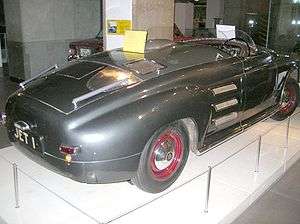
Despite the difficulties experienced with the jet engine project, Rover was interested in the development of the gas turbine engine to power vehicles.[15] In 1945, Rover hired engineers Frank Bell and Spen King away from Rolls-Royce to assist Maurice Wilks in the development of automotive gas turbines.[16] By 1949, the team developed a turbine that ran at 55,000 rpm,[16] produced more than 100 horsepower (75 kW),[17] and could run on petrol, paraffin, or diesel oil.[18] Rover's early turbine engines consumed fuel at a rate much greater than piston engines, equivalent to 6 miles per imperial gallon (5.0 mpg-US; 47 L/100 km). Although fuel consumption was later reduced by using a heat exchanger, it was never as low as that of contemporary piston engines.[18]
In March 1950, Rover showed the JET1 prototype, the first car powered with a gas turbine engine, to the public.[19] JET1, an open two-seat tourer, had the engine positioned behind the seats, air intake grilles on either side of the car,[20] and exhaust outlets on the top of the tail.[21] During tests, the car reached a top speed of 88 mph (142 km/h). After being shown in the United Kingdom and the United States in 1950,[22] JET1 was further developed,[23] and was subjected to speed trials on the Jabbeke highway in Belgium in June 1952,[24] where it exceeded 150 miles per hour (240 km/h).[25] JET1 is currently on display at the London Science Museum.
Four further prototypes were built, the P4-based front-engined T2 and rear-engined T2A saloons,[26] the rear-engined four-wheel-drive T3 coupé,[27] and the front-engined front-wheel drive T4 saloon.[28]
Rover and the BRM Formula One team joined forces to produce the Rover-BRM, a gas turbine-powered sports prototype that entered the 1963 24 hours of Le Mans, driven by Graham Hill and Richie Ginther.[29] It averaged 107.8 mph (173 km/h) and had a top speed of 142 mph (229 km/h).
Rover also ran several experimental diesel engine projects in relation to the Land Rover. The 2-litre, 52 horsepower (39 kW) diesel unit designed and built by Rover for its 4x4 had entered production in 1956 and was one of Britain's first modern high-speed automotive diesel engines. Experimental projects were undertaken to improve the engine's power delivery, running qualities, and fuel tolerances. British Army requirements led to the development of a multifuel version of the 2.25-litre variant of the engine in 1962, which could run on petrol, diesel, Jet-A, or kerosene. However, the engine's power output when running on low-grade fuel was too low for the Army's uses. Rover developed a highly advanced (for the time) turbodiesel version of its engine in the mid-1960s to power its experimental '129-inch' heavy duty Land Rover designs. This 2.5-litre engine used a turbocharger built by Rover's gas turbine division as well as an intercooler. This was one of the first times these features had been incorporated on such a small-capacity diesel unit, but they were not adopted.
After the Leyland Motor Corporation takeover, the Rover Gas Turbine was used in a number of Leyland trucks, including one shown at the 1968 Commercial Motor Show. Rover gas turbines also powered the first Advanced Passenger Train.
Golden years
.jpg)
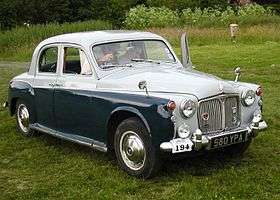
The 1950s and '60s were fruitful years for the company. The Land Rover became a runaway success (despite Rover's reputation for making upmarket saloons, the utilitarian Land Rover was actually the company's biggest seller throughout the 1950s, '60s, and '70s), as well as the P5 and P6 saloons equipped with a 3.5L (215ci) aluminium V8 (the design and tooling of which was purchased from Buick) and pioneering research into gas turbine-fueled vehicles.
As the '60s drew to a close Rover was working on a number of innovative projects. Having purchased the Alvis company in 1965 Rover was working on a V8-powered supercar to sell under the Alvis name. The prototype, called the P6BS, was completed and the finalised styling and engineering proposal, the P9, was drawn up. Rover was also working on the P8 project which aimed to replace the existing P5 large saloon with a modern design similar in concept to a scaled-up P6.
When Leyland Motors joined with British Motor Holdings and Rover and Jaguar became corporate partners these projects were cancelled to prevent internal competition with Jaguar products. The P8 in particular was cancelled in a very late stage of preparation- Rover had already ordered the dies and stamping equipment for making the car's body panels at Pressed Steel when ordered to stop work.
Rover continued to develop its '100-inch Station Wagon', which became the ground-breaking Range Rover, launched in 1970. This also used the ex-Buick V8 engine as well as the P6's innovative safety-frame body structure design and features such as permanent four-wheel drive and all-round disc brakes. The Range Rover was initially designed as a utility vehicle which could offer the off-road capability of the Land Rover, but in a more refined and car-like package.
_(2).jpg)
Mergers to LMC and BL
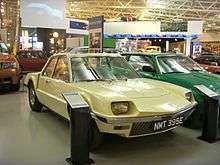
In 1967, Rover became part of the Leyland Motor Corporation (LMC), which already owned Triumph. The next year, LMC merged with British Motor Holdings (BMH) to become the British Leyland Motor Corporation (BLMC). This was the beginning of the end for the independent Rover Company, as the Solihull-based company's heritage drowned beneath the infamous industrial relations and managerial problems that beset the British motor industry throughout the 1970s. At various times, it was part of the Specialist Division (hence the factory designation SD1 for the first—and in the event, only—model produced under this arrangement), Leyland Cars, Rover-Triumph, and the short-lived Jaguar Rover Triumph. The Land Rover products however had flourished during the turbulent BLMC years, with the Range Rover in particular generating sizeable revenues for the company as it moved further upmarket. After the Ryder Report in 1975, Land Rover was split from Rover in 1978 as a separate operating company within British Leyland, and all Rover car production at Solihull ended and was switched to the Austin-Morris plants in Longbridge and Cowley for the rest of the marque's existence. The Range Rover subsequently went on to become BL's flagship product, after Jaguar was de-merged and privatised in 1984.
British Leyland entered into a collaborative venture with the Honda Motor Corporation of Japan, which resulted in a whole generation of Rover-badged vehicles which shared engineering with contemporary Honda models, which would sustain the beleaguered company and its successors until the mid-1990s.
Sale to BAe, and divestment
In 1988 the business was sold by the British Government to British Aerospace (BAe), and shortly after shortened its name to just Rover Group. They subsequently sold the business in 1994 to BMW. Honda, which had owned a 20% share in partnership with BAe, exited the business when BAe sold its share to BMW.[30]
BMW, after initially seeking to retain the whole, decided only to retain the Cowley operations for MINI production. Land Rover was sold by BMW to Ford.[30] The Longbridge production facility, along with the Rover and Morris Garages marques, was taken on by former Rover executive John Towers in April 2000 for a derisory sum under the marque MG Rover.[30] The Towers administration of MG was declared insolvent in April 2005 and the business was later refloated under the ownership of Nanjing Automobile, who moved production to China.[30]
Current Status
Legally the Rover marque is the property of Land Rover under the terms of Ford's purchase of the name in 2006. The company is now known as Jaguar Land Rover Limited, Land Rover having been sold by Ford to Tata Motors in 2008. As part of the deal with Tata the Rover marque had to remain as property of Land Rover.
Models
Launched under the independent Rover Company pre-merger (1904–1967)
- 1904–1912 Rover 8
- 1906–1910 Rover 6
- 1906–1907 Rover 10/12
- 1906–1910 Rover 16
- 1906–1910 Rover 20
- 1909–1912 Rover 12 2-cylinder
- 1908–1911 Rover 15
- 1910–1912 Rover 12 sleeve-valve
- 1912–1913 Rover 18
- 1912–1923 Rover 12 Clegg
- 1919–1925 Rover 8
- 1922–1923 Rover 6/21
- 1924–1927 Rover 9/20
- 1925–1927 Rover 14/45
- 1926–1929 Rover 16/50
- 1929–1930 Rover Light Six
- 1930–1931 Rover Light Twenty
- 1927–1947 Rover 10
- 1927–1932 Rover 2-Litre
- 1932–1934 Rover Meteor 16HP/20HP
- 1931–1940 Rover Speed 20
- 1932–1933 Rover Pilot/Speed Pilot
- 1932–1932 Rover Scarab
- 1934–1947 Rover 12
- 1934–1947 Rover 14/Speed 14
- 1937–1947 Rover 16
- 1947–1948 Rover 12 Sports Tourer
- 1948–1978 Land Rover (I/II/III)—In 1978, BL established Land Rover Limited as a separate subsidiary; it took over Land Rover production.
- 1948–1949 Rover P3 (60/75)
- 1949–1964 Rover P4 (60/75/80/90/95/100/105/110)
- 1958–1973 Rover P5 (3-Litre/3.5-Litre)
- 1963–1976 Rover P6 (2000/2200/3500)
Launched under the Rover trademark as a British Leyland Motor Corporation (later BL plc) subsidiary (1967–1988)
- 1970–1978 Range Rover—In 1978, BL established Land Rover Limited as a separate subsidiary; it took over Range Rover production.
- 1976–1986 Rover SD1 (2000/2300/2400/2600/3500/Vitesse)
- 1983–1985 Rover Quintet—Australian market
- 1984–1989 Rover 200-Series (SD3)
- 1985–1989 Rover 416i—Australian market
- 1986–1998 Rover 800-series & Sterling
Launched by the Rover Group/MG Rover as a British Aerospace/BMW subsidiary (1988–2005)
- 1989–1995 Rover 200/400-Series (R8)
- 1993–1998 Rover 600-Series
- 1994-2001 Range Rover Mk.2
- 1995-2005 Rover 200/25 (R3)
- 1995-2005 Rover 400/45 (HH-R)
- 1998-2004 Land Rover Freelander
- 1998-2005 Rover 75
- 2003-2005 Rover Streetwise
See also
References
- ↑ Phillips, Kevin. "Rover – How it all began". Retrieved 2009-02-06.
- 1 2 3 4 De Cet, Mirco (2005). Quentin Daniel, ed. The Complete Encyclopedia of Classic Motorcycles. Rebo International. ISBN 978-90-366-1497-9.
- 1 2 "Brief History of the Marque: Rover". Retrieved 2009-02-03.
- ↑ City Notes. Rover's 60p.c. Capital Loss. The Times, Monday, Dec 03, 1928; pg. 23; Issue 45066
- ↑ High Court Of Justice. Chancery Division., Reduction Of Capital The Times, Tuesday, Feb 12, 1929; pg. 5; Issue 45125
- 1 2 "Rover". British Motor Museum. Retrieved 30 March 2011.
- ↑ "The Road that Led to the Beetle". Light Auto. Retrieved 30 March 2011.
- ↑ The Rover Company, Substantial Trading Profit, High Quality Of Company's Cars The Times, Tuesday, Oct 10, 1933; pg. 21; Issue 46571
- ↑ Robson, Graham (1981). The Rover company (2 ed.). Patrick Stephens. ISBN 0-85059-543-6.
- ↑ Bobbitt 2007, p. 72.
- 1 2 3 Bobbitt 2007, p. 73.
- 1 2 Vikings at Waterloo, David S Brooks, Rolls-Royce Heritage Trust, ISBN 1 872922 08 2,1996
- 1 2 Bobbitt 2007, p. 74.
- ↑ Bobbitt 2007, pp. 73–74.
- ↑ Bobbitt 2007, pp. 74–75.
- 1 2 Bobbitt 2007, p. 75.
- ↑ Bobbitt 2007, p. 77.
- 1 2 Bobbitt 2007, p. 78.
- ↑ Bobbitt 2007, p. 82.
- ↑ Bobbitt 2007, p. 76.
- ↑ Bobbitt 2007, p. 81.
- ↑ Bobbitt 2007, p. 84.
- ↑ Bobbitt 2007, pp. 84–85.
- ↑ Bobbitt 2007, p. 86.
- ↑ Bobbitt 2007, p. 87.
- ↑ Bobbitt 2007, pp. 89–91.
- ↑ Bobbitt 2007, pp. 92–94.
- ↑ Bobbitt 2007, p. 97.
- ↑ Bobbitt 2007, pp. 100–101.
- 1 2 3 4 "1994: MPs condemn sale of Rover". BBC News. 1 February 1994.
- Bobbitt, Malcolm (2007) [1994]. "III – Gas-Turbines and the Jet Era". Rover P4 Series (revised ed.). Dorchester, UK: Veloce Publishing. ISBN 978-1-903706-57-2. Retrieved 17 October 2014.
External links
| Wikimedia Commons has media related to Rover vehicles. |
- Keith Adams Austin Rover / Rover Group / MG Rover Resource
- German Rover Company & Rover Cars Community
- Portuguese MG-Rover Club
- Polish MG Rover Club
- Spanish site of MG-ROVER
- Czech MG-Rover Community
- Catalogue of the Rover archives, held at the Modern Records Centre, University of Warwick
| British Leyland – car companies and marques | |||||||||||||||||||||||||||||||||||||||||||||||||||||||||||||
|---|---|---|---|---|---|---|---|---|---|---|---|---|---|---|---|---|---|---|---|---|---|---|---|---|---|---|---|---|---|---|---|---|---|---|---|---|---|---|---|---|---|---|---|---|---|---|---|---|---|---|---|---|---|---|---|---|---|---|---|---|---|
| Marque | 1900s | 1910s | 1920s | 1930s | 1940s | 1950s | 1960s | 1970s | 1980s | 1990s | 2000s | 2010s | |||||||||||||||||||||||||||||||||||||||||||||||||
| Jaguar | SS Cars | Jaguar | Jaguar & Daimler |
BMH | BLMC / British Leyland | Jaguar & Daimler |
Ford (PAG) | Tata | |||||||||||||||||||||||||||||||||||||||||||||||||||||
| Daimler | Daimler | BSA | BSA | ||||||||||||||||||||||||||||||||||||||||||||||||||||||||||
| Lanchester | Lanchester | ||||||||||||||||||||||||||||||||||||||||||||||||||||||||||||
| Rover | Rover Company | Rover Company | Rover Company | Austin Rover Group & Land Rover Group (BL plc) |
Rover Group (BAe) | Rover Group (BMW) |
MG Rover Group (PVH) | ||||||||||||||||||||||||||||||||||||||||||||||||||||||
| Land Rover | Ford (PAG) | ||||||||||||||||||||||||||||||||||||||||||||||||||||||||||||
| Alvis | Alvis | BAE Systems | |||||||||||||||||||||||||||||||||||||||||||||||||||||||||||
| Standard | Standard | Standard Triumph | Leyland Motors | British Motor Heritage | |||||||||||||||||||||||||||||||||||||||||||||||||||||||||
| Triumph | Dawson | Triumph | BMW | ||||||||||||||||||||||||||||||||||||||||||||||||||||||||||
| Riley | Riley | Nuffield Organisation | BMC | BMH | |||||||||||||||||||||||||||||||||||||||||||||||||||||||||
| MG | Morris Garages (MG) | Rover Group (BMW) |
MG Rover Group (PVH) | SAIC & NAC |
SAIC | ||||||||||||||||||||||||||||||||||||||||||||||||||||||||
| Morris | Morris | Morris | |||||||||||||||||||||||||||||||||||||||||||||||||||||||||||
| Wolseley | Wolseley | ||||||||||||||||||||||||||||||||||||||||||||||||||||||||||||
| Austin | Austin | Austin | |||||||||||||||||||||||||||||||||||||||||||||||||||||||||||
| Vanden Plas | Vanden Plas | ||||||||||||||||||||||||||||||||||||||||||||||||||||||||||||
| Mini | BMW | ||||||||||||||||||||||||||||||||||||||||||||||||||||||||||||
| Princess | BMC | BLMC / British Leyland | |||||||||||||||||||||||||||||||||||||||||||||||||||||||||||
| Austin-Healey | Austin (BMC) & Donald Healey | ||||||||||||||||||||||||||||||||||||||||||||||||||||||||||||
| Marque | 1900s | 1910s | 1920s | 1930s | 1940s | 1950s | 1960s | 1970s | 1980s | 1990s | 2000s | 2010s | |||||||||||||||||||||||||||||||||||||||||||||||||
